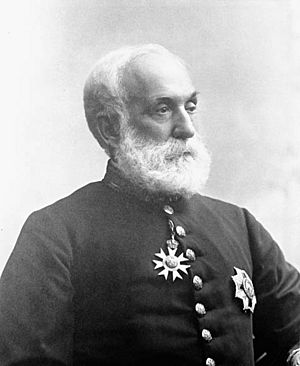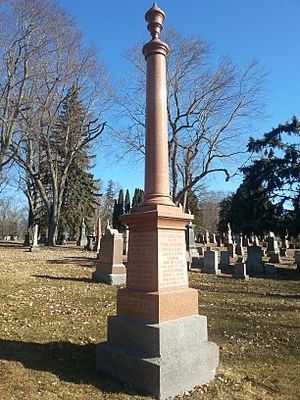Mackenzie Bowell facts for kids
Quick facts for kids
Mackenzie Bowell
|
|
|---|---|

Bowell in 1891
|
|
| 5th Prime Minister of Canada | |
| In office December 21, 1894 – April 27, 1896 |
|
| Monarch | Victoria |
| Governor General | The Earl of Aberdeen |
| Preceded by | John Thompson |
| Succeeded by | Charles Tupper |
| Canadian Senator from Quebec | |
| In office December 1892 – December 10, 1917 |
|
| Appointed by | John Sparrow David Thompson |
| Member of Parliament for Hastings North |
|
| In office September 20, 1867 – December 1892 |
|
| Preceded by | Riding established |
| Succeeded by | Alexander Augustus Williamson Carscallen |
| Personal details | |
| Born | December 27, 1823 Rickinghall, Suffolk, England |
| Died | December 10, 1917 (aged 93) Belleville, Ontario, Canada |
| Resting place | Belleville Cemetery, Belleville, Ontario, Canada |
| Nationality | Canadian |
| Political party | Conservative |
| Spouse |
Harriet Bowell
(m. 1847; died 1884) |
| Children | 9 |
| Awards | Order of St Michael and St George Canadian General Service Medal Colonial Auxiliary Forces Officers' Decoration |
| Signature | |
| Military service | |
| Allegiance | Province of Canada Dominion of Canada |
| Branch/service | Canadian militia (1861-1872) |
| Years of service | 1861–1872 |
| Rank | Lieutenant-Colonel |
| Unit | Belleville Volunteer Militia Rifle Company The Argyll Light Infantry 49th Hastings Battalion |
| Battles/wars | Fenian Raids |
Sir Mackenzie Bowell (December 27, 1823 – December 10, 1917) was a Canadian newspaper owner and politician. He served as the fifth Prime Minister of Canada from 1894 to 1896.
Bowell was born in England and moved to Belleville, Ontario, Canada, with his family in 1832. As a teenager, he started working at a local newspaper, the Belleville Intelligencer. About 15 years later, he became the owner of the newspaper.
In 1867, after Canada became a country, he was elected to the House of Commons for the Conservative Party. Bowell joined the Cabinet in 1878. He worked under three prime ministers: John A. Macdonald, John Abbott, and John Thompson. He held different roles, including Minister of Customs and Minister of Trade and Commerce.
Bowell was a Member of Parliament for 25 years. In 1892, he was appointed to the Senate. He became the Leader of the Government in the Senate the next year.
In December 1894, Prime Minister Thompson suddenly passed away. The Earl of Aberdeen, Canada's Governor General, chose Bowell to be the new prime minister. This was because Bowell was the most experienced member of the Cabinet.
A big challenge during Bowell's time as prime minister was the Manitoba Schools Question. His efforts to find a solution upset members of his own party. After a disagreement within his Cabinet in early 1896, he had to step down. Charles Tupper became the new prime minister. Bowell remained a senator until he passed away at 93 years old. He served as a Canadian parliamentarian for 50 years.
Contents
Early Life and Career
Mackenzie Bowell was born in Rickinghall, England. In 1832, his family moved to Belleville, Canada. There, he started working as a printer at the local newspaper, The Belleville Intelligencer. He became a successful printer and editor, and later, he owned the newspaper.
Bowell was also active in community groups. He was a Freemason and a leader in the Orange Order of British North America from 1870 to 1878. In 1847, he married Harriet Moore. They had five sons and four daughters together.
Military Service
Bowell was a strong supporter of the militia in Hastings County. He joined the local militia in 1856. He helped create the Belleville Volunteer Militia Rifle Company in 1857. He served with them during the Trent Affair.
He also joined the 15th Belleville Battalion in 1863. He was promoted to captain and fought in the Fenian Raids in 1866. For his service, he received the Canada General Service Medal. He continued to rise in rank, becoming a Lieutenant-Colonel before retiring from the militia in 1874.
Entering Politics
Mackenzie Bowell was first elected to the House of Commons in 1867. He represented the riding of Hastings North, Ontario, as a Conservative. He kept his seat even when the Conservatives lost the election in 1874. Later that year, he played a key role in having Louis Riel removed from the House of Commons.
Joining the Cabinet and Senate
In 1878, when the Conservatives were back in power, Bowell joined the Cabinet. He became the Minister of Customs. In 1892, he became the Minister of Militia and Defence. He had been a Member of Parliament for 25 years by then.
Bowell was a skilled and hardworking administrator. He remained in the Cabinet as the Minister of Trade and Commerce, a new role, after he became a senator in 1892. In 1893, he visited Australia. This visit led to the first meeting of leaders from British colonies and territories, held in Ottawa in 1894. He became the leader of the government in the Senate in October 1893.
Prime Minister (1894–1896)
In December 1894, Prime Minister John Sparrow David Thompson passed away suddenly. As the most senior Cabinet minister, Bowell was chosen by the Governor General to take his place. This made Bowell one of only two Canadian prime ministers to hold the job while serving in the Senate, not the House of Commons.
The Manitoba Schools Question
As Prime Minister, Bowell faced a big challenge called the Manitoba Schools Question. In 1890, the province of Manitoba stopped giving public money to religious schools, both Catholic and Protestant. Many people thought this went against the rules set for religious schools in the Manitoba Act of 1870.
After some court cases, it was decided that the federal government could make a law to force Manitoba to bring back the funding.
Trouble in the Cabinet
Bowell and the prime ministers before him tried to solve this problem. It caused disagreements across the country and even within Bowell's own Cabinet. Bowell found it hard to deal with the issue because he was unsure about what to do. Also, as a senator, he could not speak in the debates in the House of Commons.
Bowell supported a law that would have made Manitoba restore its Catholic schools. But he delayed it because some members of his Cabinet disagreed. Government business stopped, and several Cabinet members thought Bowell was not a good leader. To make him step down, seven ministers resigned.
Resigning as Prime Minister
Bowell was forced to resign. After ten days, the Governor General helped solve the problem. Six of the ministers returned to their jobs. However, the real leadership was then held by Charles Tupper. Tupper had been Canada's representative in the United Kingdom. He was called back by the ministers who wanted to replace Bowell. Bowell officially resigned and Tupper became prime minister at the end of the parliamentary session.
Later Life and Death
Bowell stayed in the Senate. He was the leader of his party there until 1906. After that, he served as a regular Senator until he passed away in 1917. He had served as a federal politician for over 50 years.
He died from pneumonia in Belleville, just before his 94th birthday. He was buried in the Belleville cemetery. Many members of the Orange Order attended his funeral.
Legacy
Bowell was named a National Historic Person in 1945. This means he is recognized as someone important in Canada's history.
In 1954, Canada Post honored Bowell with a special stamp. It was part of a series about prime ministers.
In a 1998 study, historians ranked Bowell #19 out of 20 Canadian Prime Ministers up to that time.
For a long time, there was no full book about Bowell's life. This changed in 2017. A historian named Betsy Dewar Boyce wrote a book called The Accidental Prime Minister. It was published 100 years after Bowell's death.
See also
 In Spanish: Mackenzie Bowell para niños
In Spanish: Mackenzie Bowell para niños
- List of prime ministers of Canada





